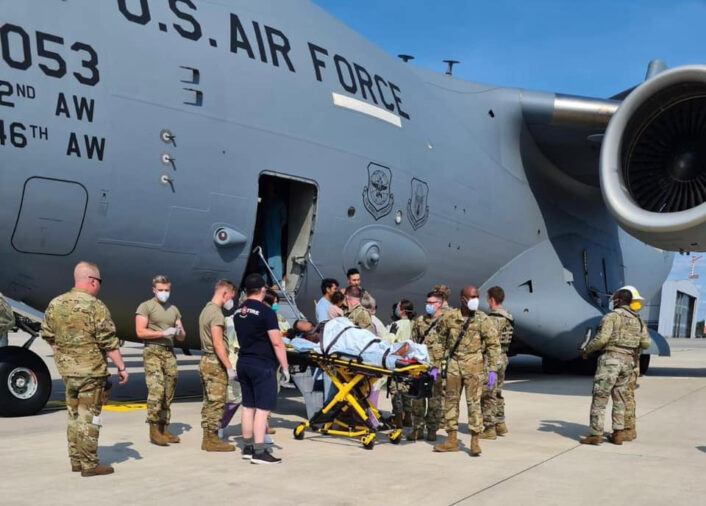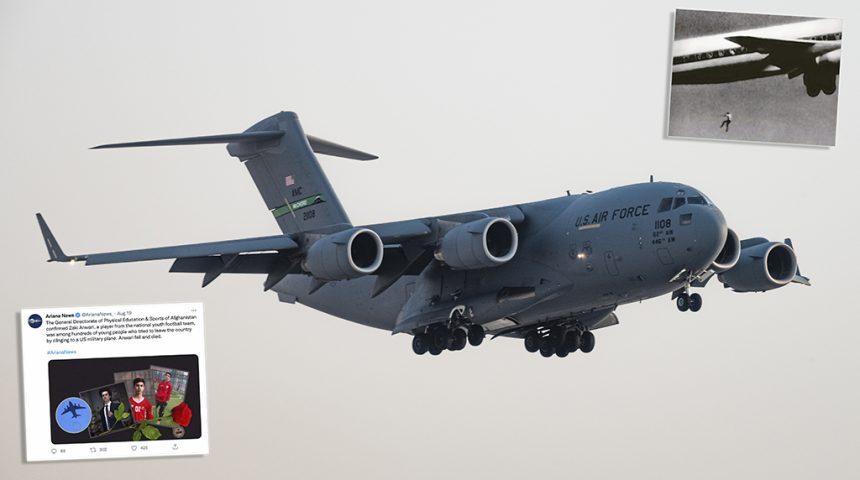We Look at the C-17A’s Landing Gear and Several Other Attempted Air Stowaways.
Shocking images of people falling from a USAF C-17A Globemaster III as it departed Kabul last week tore across the internet as media around the world tried to understand what happened at Hamid Karzai International Airport in Afghanistan.
What actually happened in those harrowing moments before and just after take-off of the C-17A captured in video and photos that have appeared around the world? TheAviationist.com visited the National Museum of the U.S. Air Force at Wright-Patterson AFB in Dayton, Ohio, to look at a C-17A landing gear to try to understand more about this frightening incident.
The C-17A Globemaster III uses a massive main undercarriage to support its typically heavy loads. With a maximum payload capacity of 170,900 pounds, and a maximum gross takeoff weight of 585,000 pounds- over 290 tons, the demands placed on the main landing gear trucks of the C-17A are substantial. These heavy loads necessitate the massive main landing gear design on the C-17A.
The main landing gear trucks, or large, multi-wheel assemblies that support most of the aircraft’s weight on the ground, retract into wide protrusions on each side of the C-17A at the lower, mid fuselage. This design is shared on several heavy airlifters around the world including the C-130 Hercules, Russian Ilyushin IL-76, the Airbus A400M Atlas and the Chinese Xi’an Y-20.
During the beginning of the takeoff roll at Kabul, a number of men climbed onto these main landing gear fairings. It is possible that some of the men did not understand that the landing gear doors would fold flush with the aircraft.
There have also been suggestions that persons may have actually climbed inside the landing gear wheel wells. A story in the Washington Post revealed that the flight crew of the C-17A could not fully retract their landing gear after takeoff from Kabul and declared an in-flight emergency. Once the emergency was declared, the flight crew of the C-17A diverted to an alternate landing area “in a nearby country” and made a successful emergency landing according to the Washington Post.
The emergency landing area was later reported as Al Udeid Air Base, in Qatar. Upon inspection of the main landing gear, “human remains were discovered in the compartment that holds the plane’s landing gear after it retracts”.
“The aircraft is currently impounded to provide time to collect the remains and inspect the aircraft before it is returned to flying status”, U.S. Air Force spokesperson Ann Stefanek told the media in an email release. Stefanek went on to say that the Air Force, “Is reviewing all available information regarding a C-17A aircraft that departed Hamid Karzai International Airport [on Aug. 16] and the loss of civilian lives — to include video documentation and the source of social media posts,”.
Three days after the tragedy, on Aug. 19, 2021, after video appearing to show two persons falling from the C-17A surfaced across social media, it was reported by the General Directorate of Physical Education and Sports of Afghanistan that one of the persons seen falling from that aircraft on Monday, August 16, was a national team football player named “Zaki Anwari”. According to the report in Ariana News, Anwari, “Fell to his death while trying to escape the Taliban regime”.
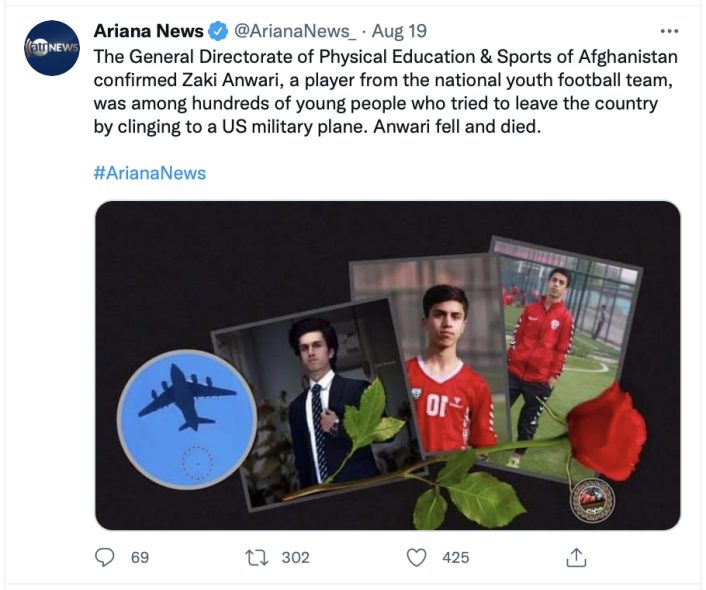
The Aviationist.com spoke to an airport firefighter in Michigan about the chances of a person surviving inside the landing gear wheel well of an aircraft as a stowaway. “I’ve seen two people who tried, neither one survived. It’s impossible at the altitudes and temperatures these planes fly”.
There have been other sensational incidents of people trying to cling to aircraft landing gear in an attempt to stow away on an aircraft. On February 22, 1970, a 14-year old boy in Australia named Keith Sapsford climbed into the landing gear wheel well of a Douglas DC-8 at Sydney Airport. The aircraft was bound for Tokyo, but Sapsford did not survive the takeoff.
In an incident oddly similar to the recent tragedy at Kabul, Afghanistan, Keith Sapsford was able to remain inside the landing gear compartment until the DC-8 reached an altitude of 200-feet. When the landing gear began to retract, the main landing gear door Sapsford was on opened to allow the main landing gear to retract. Sapsford fell out of the aircraft to his death. Remarkably, photographer John Gilpin was taking photos of aircraft taking off from Sydney Airport, and captured a photo of Sapsford’s tragic death.
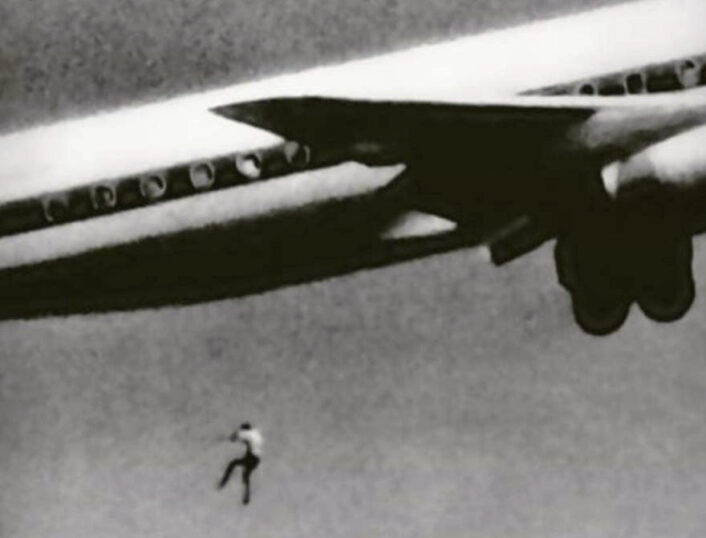
Perhaps even more remarkably, there have been stowaways who survived inside an aircraft landing gear wheel well on extended flights. On April 20, 2014, 15-year old Somalian Yahya Abdi stowed away inside the main landing gear wheel well of a Hawaiian Airlines Boeing 767 on a flight from San Jose, California to Maui, Hawaii. The five-and-a-half-hour flight reached an altitude of 38,000 ft., where the unpressurized landing gear compartment on the aircraft would have been well below freezing and had little oxygen due to the extreme altitude. Surveillance video of the aircraft after landing in Maui showed Yahya Abdi lowering himself from the wing and staggering across the tarmac, apparently dazed from lack of oxygen and hypothermia. According to a report on CNN when the incident happened in 2014, Abdi was trying to, “see his mother in Africa, where she lives in a refugee camp in Ethiopia”.
Before the tragedy of men clinging to the outside of an aircraft in Kabul, Afghanistan last week, film star Tom Cruise of Top Gun fame had performed an oddly similar movie stunt for the 2014 action film, Mission: Impossible – Rogue Nation. Cruise clung to the outside of an Airbus A400M Atlas for an action sequence in the movie. The scene was shot with Cruise actually outside an A400M, attached to the aircraft using a safety harness and mountaineering webbing. Cruise told Hollywood film magazines that doing the stunt was, “Terrifying”.
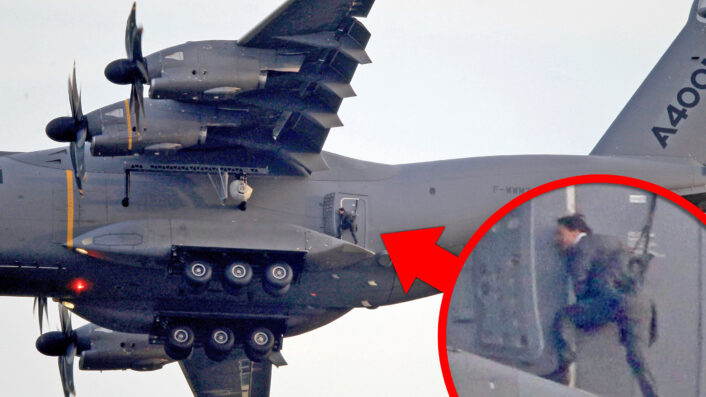
But the history of refugee evacuations from war-torn nations is very different from Hollywood depictions of action film stars performing stunts.
Perhaps the most tragic example is the terrifying 1975 Tan Son Nhut, Vietnam C-5A Galaxy crash that killed 138 refugees, Defense Intelligence Agency personnel and U.S. Air Force personnel who were evacuating the country in a hauntingly similar incident to the Kabul, Afghanistan C-17 flight.
The Tan Son Nhut refugee flight tragedy happened on April 4, 1975 when a USAF C-5A Galaxy experienced the failure of its rear cargo door at 23,000 ft. above the South China Sea off the South Vietnamese coast. The aircraft had just departed Tan Son Nhut Air Base for Clark Air Base in the Philippines and was ultimately bound for the U.S. with a load of Vietnamese orphans and U.S. personnel.
The flight crew of the ill-fated C-5A Galaxy managed to wrestle the massive, crippled aircraft down to final approach for an emergency landing at Tan Son Nhut, but the aircraft could not maintain altitude and crashed into a rice paddy, broke into four large sections and caught fire. Tragically, 78 Vietnamese orphans being evacuated to freedom died in the crash along with 35 employees the Defense Attache’ Office and 11 USAF crewmen. Miraculously, there were 176 survivors of the crash, mostly those who were seated on the second level of the giant cargo aircraft.
But despite the tragic news following the deaths of refugees attempting to flee Afghanistan there was a story of hope that emerged on Saturday, Aug. 21, 2021. According to reports that surfaced on Twitter, Medical support personnel from the USAF 86th Medical Group helped an Afghan mother deliver a baby onboard a C-17 Globemaster III, callsign “Reach 828”, that had just touched down at Ramstein Air Base after flying refugees out of Afghanistan.
The C-17A flight crew may have saved the lives of both the mother and unborn baby when they descended from their previous altitude to raise the pressure in the aircraft after the mother went into labor and began experiencing complications. According to a report on Twitter, the flight crew’s change in altitude, “helped stabilize and save the mother’s life”.
